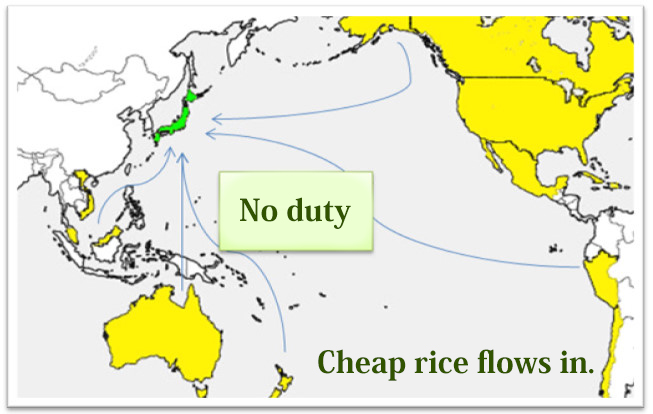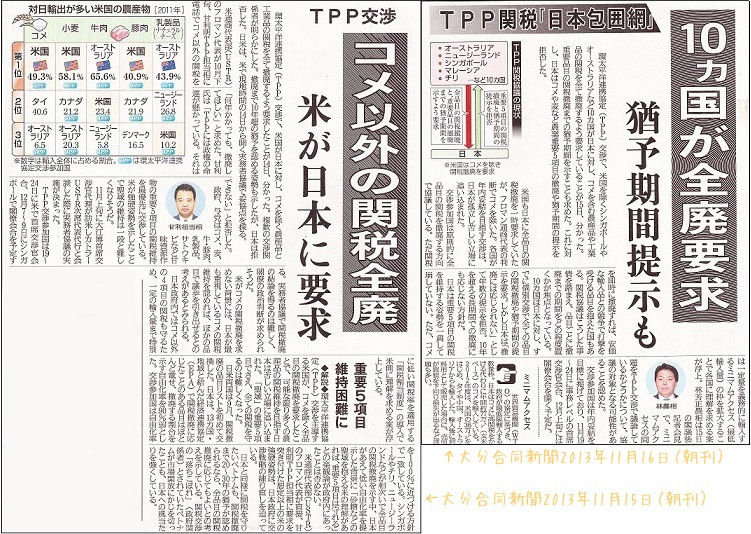This page explains TPP, about which we have often heard recently.
üscontentsüt
üEAdvantages of joining TPP.
üEDisadvantages of joining TPP.
üEThe first advantage, "An increase in sales of exports".
üEThe second advantage, "An increase in GDP(Gross Domestic Product)".
üEThe first disadvantage, "Farmers will be seriously damaged".ü®TPP relating to rice.
üEThe second disadvantage, "Permitting all of treatment partially covered by insurance".
üEJapan officially joined TPP negotiations.
üEProtection for farmers.
üENEW! America requests Japan to eliminate tariffs on everything except rice. The other countries request Japan to eliminate all tariffs.ü®TPP relating to rice.

TTPP is a comprehensive agreement to make trade free: especially, it's principle is to eliminate tariffs, which is negotiated by countries surrounding the Pacific.
Its important principle is ügeliminating tariffüh.
Singapore, New Zealand. Chile, and Brunei signed TPP in June 2005.
And it was entered into force in May 2006.
After that, the 7 countries; America, Australia, Peru, Vietnam, Malaysia, Mexico, and Canada, joined it.
Japan joined it late in 2013.
Now, the 12 countries are negotiating.
ć@Sales of exported Japanese goods will increase because "free trade" will be developed by "eliminating tariffs".
ćAGlobalization will be accelerated.
As a result of that, GDP(Gross Domestic Product) will increase.
ć@Farmers in Japan will be seriously damaged because of imported foreign produce (especially, rice). ćAIt is expected that treatment partially covered by insurance is perfectly permitted.
Sales of exported Japanese goods will increase because "free trade" will be developed by "eliminating tariffs".
Japan will be able to compete with the other countries because tariffs are eliminated.
As a result of that, sales of exports will increase.
Globalization will be accelerated.
As a result of that, GDP(Gross Domestic Product) will increase.
According to the trial calculation, the GDP of Japan will increase by 0.66%(3.2 trillion yen) if tariffs are eliminated.
ü”The contents of total do not reach 0.66%, however, it follows official date.
Farmers in Japan will be seriously damaged because of imported foreign produce (especially, rice).

The Japanese government bans importing foreign rice except "minimum access" by adding high tariffs.
The aim is to protect Japanese farmers.
However, foreign rice will be heavily imported to Japan if tariffs are eliminated by the TPP agreement.
It is feared that Japanese rice will cease to be bought; there fore agriculture may decay.
It is expected that treatment partially covered by insurance is perfectly permitted.
America is requesting "the principle that profit is given priority" from Japanese hospitals.
As a result of that, it is expected that Kongoshinryo is perfectly permitted.
What is "Kongoshinryo(billing of mixed medical care services on Japanese health care system)"?
"Kongoshinryo" is to let people be under both treatment covered by insurance and that not covered.
At present, collecting a payment for treatments not covered by insurance is banned if the hospital does Kongoshinryo.
If they collect a payment, the patient has to pay for all treatments.
üsTwo problems of Kongoshinryoüt
ć@The Japanese government is trying to change conditions of giving insurance.
Treatment which is covered may cease to be covered by permitting Kongoshinryo.
ćAPatients will have to pay for treatments which are not covered if Kongoshinryo is permitted.
As a result of that, rich people can receive better treatments.
On the other hand, poor people cannot receive better treatments.
In a word, a medical gap will broaden depending on whether the patient is rich or poor.
Japan joined a negotiation meeting of TPP for the first time on July 23rd, 2013.
Economic regeneration minister Kanri promised to protect the interests of Japan.
However, farmers and medical groups are still strangly apposed.
Agriculture minister Yoshimasa Hayashi promised to protect tariffs on rice and soon.
However, it is thought to be difficult for japan to protect them because Japan belatedly joined the negotiations.
There were articles about TPP in Oita Godo Newspaper on November 15th and 16th, 2013.
According to the articules, America requested Japan to eliminate tariffs on all crops and industrial products except rice.
On the other hand, the other ten countries requested Japan to eliminate all tariffs, including that on rice.
But Japan will not eliminate tariffs on the five important items.
Therefore, Japan refused the American request to eliminate tariffs on everything expect rices however long it takes.




